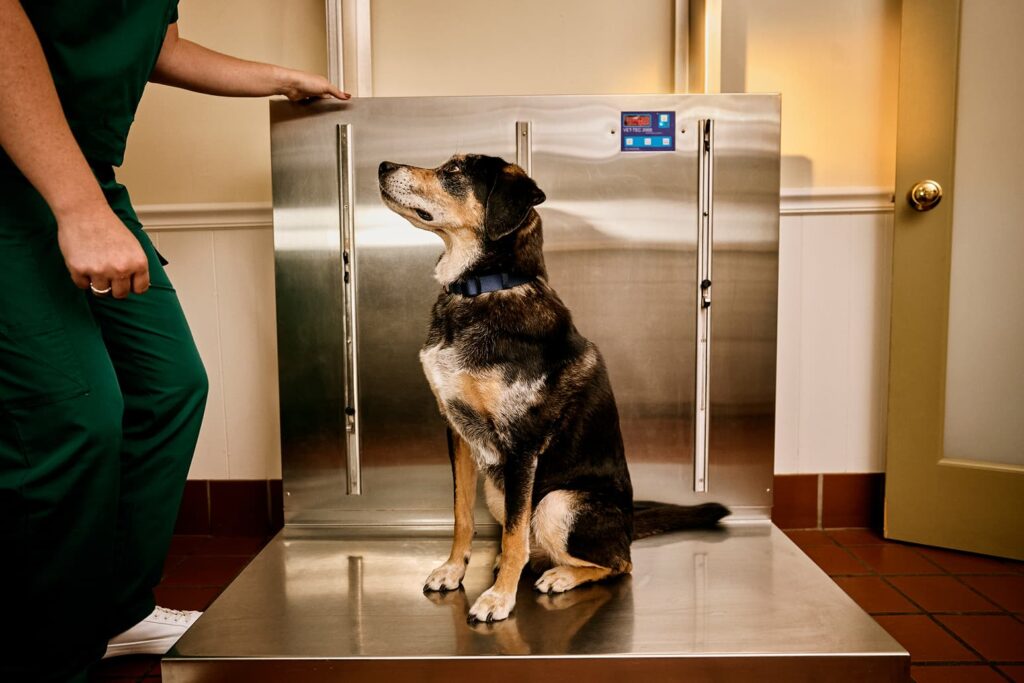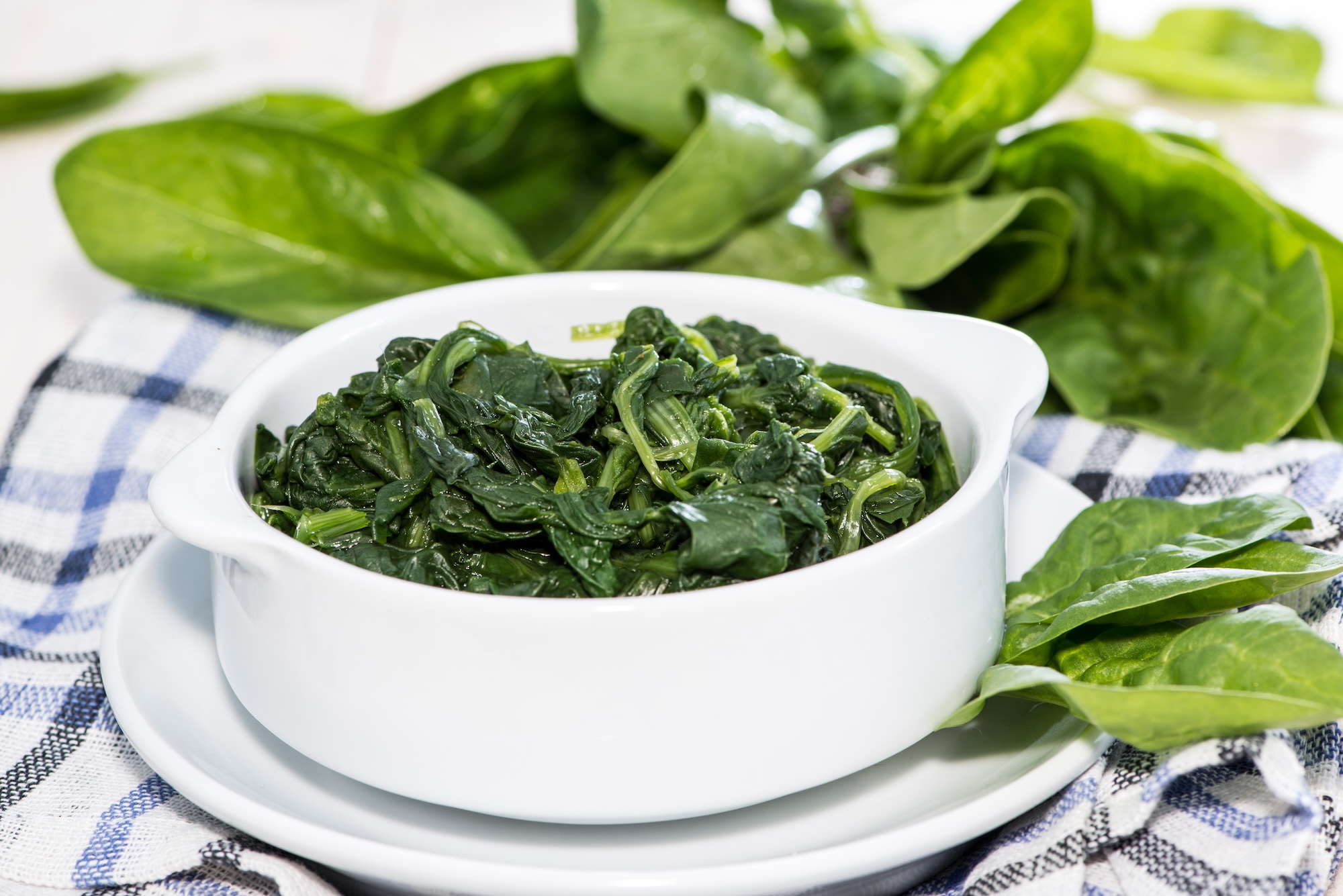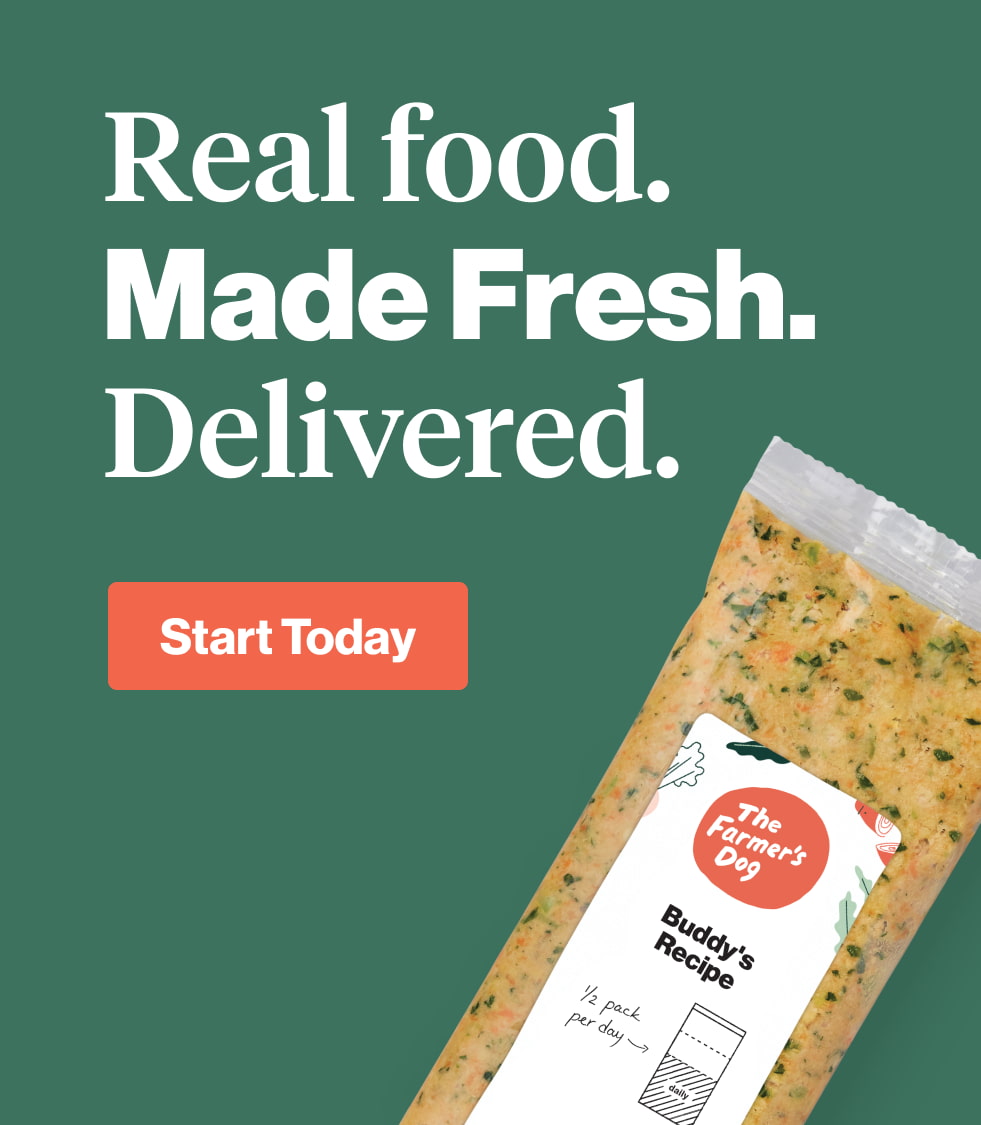In this article:
- What are the WSAVA Guidelines on Selecting Pet Foods?
- Should companies be able to answer questions in the WSAVA Guidelines on Selecting Pet Foods?
- Does The Farmer’s Dog Meet WSAVA’s Guidelines on Selecting Pet Foods?
- Who should formulate dog food?
- What types of research should pet food companies conduct?
- Is it better for pet food companies to own their facilities, or use third-party facilities?
- How should you portion your dog’s food?
- What’s the bottom line to consider when choosing a dog food?
If you’ve found yourself on this page, you care deeply about what you feed your dog. And, with countless choices on the market, you may be wondering how to determine which food is best for their health. The World Small Animal Veterinary Association (WSAVA) knows that it can be challenging to make this choice on your own, especially as so many companies use unregulated terms like “holistic” and “premium” to market their foods. “A lot of the information on the bag,” WSAVA President Dr. Jim Berry said, “is targeted more to a marketing perspective than it is to the nutrients and the actual health benefits for the animals.”
That’s why WSAVA’s Global Nutrition Committee publishes its Guidelines on Selecting Pet Foods, an easy-to-follow resource that gives veterinary professionals and pet owners guidance about what to look for in a brand and on a label while navigating this crucial choice. The Farmer’s Dog meets or exceeds all of WSAVA’s guidelines.
Recently, The Farmer’s Dog CEO Jonathan Regev sat down with Dr. Berry to talk in depth about these guidelines and how people can best look after their dogs’ health. Here are highlights from their conversation.
Companies should be able and willing to answer the questions in WSAVA’s guidelines.
Dr. Berry was clear that WSAVA does not officially approve or endorse any specific pet foods. Rather, the guidelines are about keeping pet owners informed and ensuring transparency.
“Nutrition is a huge area, and it is confusing,” Dr. Berry said. As a result, WSAVA provided “a series of questions so that [veterinarians and pet owners] could look at any company on the market and have some ground rules for: ‘Is this a company that potentially has some good products, or is this a company that maybe I want to take a pass on and look at something else?’ So it’s a baseline that gives everybody a framework of how to ask questions, [and] how to make some rational decisions.”
It’s important that companies be willing and able to answer the questions in these guidelines specifically. If they can’t or won’t, that’s a bad sign.
“None of the questions in the guidelines are particularly difficult,” Dr. Berry said. Any company you’d trust with your dog’s health should be willing to answer them.
Do you have questions for us? You can reach The Farmer’s Dog at any time by emailing help@thefarmersdog.com or calling 646-780-7957.

Does The Farmer’s Dog Meet WSAVA Guidelines?
Asked whether The Farmer’s Dog meets WSAVA’s standards, Dr. Berry confirmed that we do: “From what I’ve seen,” he said. And he has done his due diligence. “I’ve scoped you out. I’ve looked at the company clearly.”
You should know who formulates your dog’s food.
The Farmer’s Dog food is formulated by on-staff, board-certified nutritionists. We employ full-time Board-Certified Veterinary Nutritionists® and a board-certified companion animal nutritionists.

Dr. Berry explained why this matters:
“There’s nothing the matter with hiring somebody as a consultant, but consultants by nature are brought in for a specific part of a project—or maybe the formulation of the food. And then, once that’s formulated and they’re at the manufacturing stage, that consultant is no longer employed by that company. And so then, in the manufacturing process, who’s looking after that? If there’s nobody with a nutrition background in the production line, who’s looking after if ingredients change or the quality of the ingredients changes? Who’s looking after food safety? Who’s looking after interactions?”
At The Farmer’s Dog, our full-time, on-staff, board-certified nutritionists remain involved with our food long after its initial formulation—supporting product claims, developing research protocols, and more.
“If you have somebody who is employed as a nutritionist full-time by that company,” Dr. Berry explained, “they’re there for all stages of manufacturing. They’re there when the product changes.”
Companies should also be testing the nutritional value of their completed product, not only the ingredients coming in.
“From the point of view of a practicing veterinarian,” Dr. Berry said, “if all they’ve done is look at the ingredients coming in and tested the nutrients before processing, I have no idea what those nutrients are at the end of processing—because of interactions, because of the processing effects, heat extrusion, etcetera.”
At The Farmer’s Dog, we know that our food is 100% complete and balanced after it’s been gently cooked to eliminate pathogens, because we test every batch of our completed product for nutritional adequacy and food safety.
Research matters.
Your dog’s food should be backed by science. Dr. Berry told us that there are certain steps companies should take on this front. “I think every company should be doing research on their own food,” he said, in terms of the nutrient analysis, making sure that it is appropriate for the animals that it’s being fed to or produced for, and making sure it’s safe. You want to look at safety standards and production standards.”
Specific claims should be backed by peer-reviewed evidence.“If it doesn’t have good peer-reviewed science behind it,” Dr. Berry said, “then it’s an anecdote.”
The Farmer’s Dog relies on published research, not only anecdotal evidence, to guide its product and service. It’s how we determine the right ratios of Omega-3 fatty acids to support memory and learning in puppies; how we develop our personalized portioning guidelines to keep dogs in healthy body condition; and how we choose the right mix of vitamins, minerals, and high-quality proteins that support dogs’ long-term health.
Multiple recipes from The Farmer’s Dog have been through AAFCO feeding trials. We’ve partnered with the Cornell University College of Veterinary Medicine on a long-term feeding study in a controlled setting that involved 25% more dogs and testing five times as many blood values as a traditional AAFCO trial—which offered even more evidence that our food meets dogs’ dietary needs. We’ve also conducted a long-term feeding study in which we fed The Farmer’s Dog to dogs living with families for up to six years.
You should know how, and where, your dog’s food is made.
A company should be willing to tell you whether they manufacture their food themselves or use another facility, and what type of oversight their facilities receive. There’s nothing wrong with facilities owned by the pet food company, or third-party facilities, as long as the company takes the right precautions to make sure the food is safe.
“If you have a dedicated line,” Dr. Berry said, “and all they’re producing is one product or one company, and everybody on that line has the experience of that product, and the company has control over the raw products coming in, there’s no reason that should not be excellent-quality food.” Conversely, if a company lacks control over these important aspects of their food production, that can be a major concern.
We have a team of credentialed food safety experts, including a full-time dedicated microbiologist, focused on screening, monitoring, and verifying the safety and quality of all of our products. They oversee every ingredient, manufacturer, and final product.
It also helps when companies employ third-party testing to ensure the nutritional content and safety of their food. Every one of our ingredients is inspected and tested by a third-party laboratory. And we go above and beyond traditional pet food manufacturing standards and regulations by partnering with USDA-inspected and FDA-registered facilities in the U.S. that produce human food. In addition, we require all locations to maintain a third-party Global Food Safety Initiative (GFSI) certification.

The serving guidelines on bags are often wrong—and that can put dogs at risk of obesity.
Talking about issues with pet food labeling, Dr. Berry cited serving guidelines as a major issue. “The thing that irks me the most,” he said, “at least in North America, is the amounts suggested for feeding are nowhere near what they should be. They’re always overestimating. And so we seem to have sort of a situation where the companies are promoting overfeeding, which to me is promoting bad welfare.” He’s right to be concerned: The Association for Pet Obesity and Prevention (APOP) has found that the majority of dogs in the U.S.—59%—are considered overweight or obese. And the condition is linked to health problems including diabetes, orthopedic diseases, and cancer.
Dr. Berry would prefer an approach tailored to individual dogs’ actual needs. “I would much rather that the companies drop [the recommendations on the bag] and put in a body-condition scoring and a muscle-condition scoring chart,” he said, “and tell people to use that. It’s so much more useful. It’s easier, and medically it makes sense.”
The Farmer’s Dog recognizes the importance of healthy body condition—research shows that dogs at a healthy weight can live 2.5 years longer than those who are overweight. That’s why our fresh food comes pre-portioned for each dog, taking into account their age, weight, body condition, breed, activity level, spay/neuter status, and other factors. This more precise portioning system (no weighing, or guesstimating cups or scoops vs. weight ranges) makes it easier to manage a dog’s weight. And it’s easy to change their portions as they grow, as their needs change, or as directed by your veterinarian.
The bottom line is: You should know as much as you can about what your dog is eating.
Every dog is different, and it’s up to you and your veterinarian to decide which food is right for your best friend. But it’s vital for you to make an informed decision, and WSAVA’s guidelines are a great tool to help you do that.
“Find the sections of the guidelines that you want answers to,” Dr. Berry recommended. “Look up the product you want, and go in and see if any of those questions are already answered for you. The next step would be to either talk to your veterinary team or call the company directly. Every good food company out there has people on the front line who are not only willing to, but want to speak to the public and can answer these questions.”




